Scott Hamilton – 18 December, 2018
Since its foundation a decade ago, the Seleka Art and Kava club has established an international reputation. Its members have exhibited their work across the Pacific, and enjoyed residencies in New Zealand and Australia. When Prince Harry and Princess Meaghan recently visited the Friendly Islands they were introduced to Tevita Latu, who did them the honour of putting on a clean shirt and scraping the paint flecks from his beard. Now Corban Estate is about to host an exhibition by Latu and the New Zealand-based painter Julian Hooper.
Auckland
Julian Hooper and Tevita Latu
Over the Water
14 December 2018 - 10 February 2019
10.53 am
The kids and I have arrived late. We stopped on our way at Glen Eden library, which is running a Teddy Bear sleepover in the lead-up to Christmas. Lui and Aneirin presented Time Bear and Snow Bear at the counter; a librarian took down the creature’s names, tagged their paws, got my phone number, ‘in case of emergencies’, placed the pair in a large basket filled with soft toys, and told us to return after the weekend. The bears will each get a certificate, commemorating their time in the library; their photos will appear in a small book. Lui warned the librarian that Time Bear has a penchant for disappearing into the past; his carers would have to be vigilant, lest he vanish into the Ice Age, or skip back to the Jurassic.
While we were depositing the bears Santa Claus hurried into the library. He had half an hour, he explained, to pose with the kids who were already surrounding him; after that, there was a shopping mall, somewhere further west, to visit. I don’t whether it was the warm weather or the stress of a schedule that made beads of sweat hang like icicles from Santa’s false beard.
Now we’ve arrived at Homestead Galleries, on the eastern, railside end of Corban Estate, a recommissioned winery in Henderson. Two of the galleries here are occupied by complicated installations; the third boasts a large table, where Tevita Latu and Taniela Potelo sit with a dozen or so children.
For me, the scene in this room is both familiar and odd. The eviscerated magazines and snapping scissors and leaking glue pens on the table remind me of the art-making sessions at Seleka’s clubhouse in Nuku’alofa. As Potelo and Latu move around the table, praising the compositions that their young friends are assembling, I recognise the warmth and curiosity that have them mentors to hundreds of young Tongans.
On night after night, during my sojourns in Tonga, I sat drinking kava and watching the Selekarians cutting, pasting, painting, drawing, and sculpting. But this tidy, well-lit room is very different from the smoky driftwood and palm shack the Selekarians called home in Tonga. I miss the disco ball that turned from the ceiling of Selaka’s headquarters, and the undanceable music - sometimes thrash metal, sometimes impossibly torpid reggae - emitted from the club’s stereo. I feel thirsty, but I look about in vain for the kava bowl - a plastic bucket, with a toilet lid clipped to its rim - that helped make Seleka notorious amongst conservative Tongans.
Since its foundation a decade ago, the Seleka Art and Kava club has established an international reputation. Its members have exhibited their work across the Pacific, and enjoyed residencies in New Zealand and Australia. Selekarians featured in the Tongan episode of Sam Neill’s TV documentary series Uncharted, and when Prince Harry and Princess Meaghan recently visited the Friendly Islands they were introduced to Tevita Latu, who did them the honour of putting on a clean shirt and scraping the paint flecks from his beard. Now Corban Estate is about to host an exhibition by Latu and the New Zealand-based painter Julian Hooper.
A notice on the wall of the room reminds me that this art-making session is running from ten-thirty until noon. After lunch, the room will presumably have new occupants. There’ll be no epic binge of kava drinking and creativity here.
10.58
Aneirin and Lui settle into spare chairs, take up scissors with the glee of mad surgeons, and attack a magazine. Lui gouges out a photograph of lumps of unrefined gold, and pastes it to the page Tevita Latu provides. If his beard were white rather than black, Latu would resemble a Tongan Santa Claus. He moves around the table with a unforced bonhomie, offering the gift of his advice to these young artists.
Taniela Potelo sits quietly at the end of the table, as he helps a boy tear bright spots of colour from magazine advertisements. They begin to glue the fragments together; their emerging collage reminds me of a Byzantine mosaic.
11.14
In my favourite part of Harry Sinclair’s 1997 film Topless Women Talk About Their Lives, a character rides up Auckland’s main street in a taxi, gazing out her window at grey faces and buildings and sky. Suddenly the view in the window changes: the tropical island of Niue lies far below, in an indigo sea. Sinclair’s jump-cut emphasises how easy travel between New Zealand and its island neighbours had become, by the end of the twentieth century.
If we can afford a ticket, we can fly in a handful of hours over an ocean that once tormented schooners and vaka for weeks. In the modern era, Marx said, space is annihilated by time. But if the travel time between temperate New Zealand and tropical Polynesia has shrunk, the difference between the two places has not. When they reach Niue, where they will be guests at a wedding, Sinclair’s characters are confronted by the otherness of the local culture. Used to the towers of Auckland, they find it hard to relate to the Niueans, who are more comfortable shimmying up coconut trees than riding elevators.
Many Kiwi visitors to Tonga remark on the languor of daily life in the kingdom. They talk, in either irritated or appreciate tones, of ‘Tonga time’, and remember shops that opened an hour late, guides who missed appointments, cars that moved as slowly as puaka down potholed roads.
When I visit Tonga I feel my body change. My heart beats slower; the blood in my veins seems to move languidly, like lagoon water at low tide; my limbs demand to be liberated from trousers and long-sleeved shirts, so that they can embrace the humid air like an old friend.
The Selekarians are not lazy. They produce hundreds of artworks a year, and sell them in local markets as well as foreign galleries. Tevita Latu is proud of his club’s productivity; one of the provocative homemade T shirts he likes to wear around Nuku’alofa features the slogan Work F**king Harder.
But could some of the industry of the Selekarians be dependent on the languor of Tonga? Only a small minority of Tongans work for a wage or salary; many are able to survive on the produce from family plantations, and on remittances from kin living abroad. Few people have to pay rents, or service mortgages. By basing himself in Tonga, Tevita Latu has been able to give himself to his calling with a single-mindedness that would be hard to achieve in the West.
When I try to think of a New Zealand parallel to the conditions that have enabled the Selekarians, I turn to the Dunedin music scene of the eighties. In his book about that scene, Matthew Bannister remembered how the songwriters who made Flying Nun famous treated the dole like an ‘unofficial arts benefit’. Made relatively secure by their state stipend and cheap rents, they were able to spend almost all their time writing, jamming, playing live, and recording.
11.27
Tevita Latu comes over to say Malo e lelei, tells me he’ll be here for a month, and mentions that he’s organising a ‘Seleka-style’ kava party at the house of an ex-member in Mount Roskill. I want to go to the party, and not only because of my fondness for kava. I want to see whether the atmosphere of the Seleka Club, of those languorous, industrious evenings in the smoky Nuku’alofa shack, can be transferred to this temperate, time-obsessed city.
11.38
The clock. It stands at the end of the corridor, near Homestead Galleries’ reception. It is unobtrusive yet oppressive, like an off-duty cop at a party.
In his great essay ‘Time, Work-discipline, and Industrial Capitalism’, EP Thompson talks about how business owners in nineteenth century Europe had to bludgeon and bribe their mill hands and miners into turning up day after day, and working steadily through each day. By the time unions had formed, and the forty hour week had been won, time-discipline had been internalised by most workers. Their culture had come to value steadiness and productivity, and to disdain idlers. Clocks ticked inside their heads.
Today many commentators lament the West’s fixation with routinised work, and point out that our technology ought to allow us to more hours of idleness. But even when they are turned loose from their office cubicles, today’s workers find it difficult to forget the clock. Even in our leisure time, we find ways to be busy: jogging, renovating our homes, walking our dogs, uploading photos to social media, and doing anything else to avoid boredom, that state Martin Heidegger equated with an awareness of the passing of time.
The time-discipline that EP Thompson described may be taken for granted in New Zealand, but it has not been successfully imposed on most Pacific societies, despite decades of effort by colonial administrators, palangi entrepeneurs, and World Bank advisors. Even if they toil for a wage or salary, Tongans are liable to drop their tools or laptops whenever their presence is required at a harvest, or a church convention, or a twenty-first birthday. Work is less important than family, food, kava, god.
11.48
I talk with the artist and film maker Vea Mafile’o, whose kids are busy collaging. Last winter Mafile’o installed a series of films, each of which featured an interview with a Tongan-based friend, in central Auckland’s St Paul’s gallery. She called the films ‘digital kava circles’, because they aimed to replicate, on a screen, the relaxed, garrulous atmosphere of Tongan drinking parties.
For the show at St Paul’s, Mafile’o ‘stitched’ together dozens of different film clips onto a screen that had the rectangular shape and vast size of a barkcloth painting made for an important ceremony. Stepping off a jammed, noisy Symonds Street into St Paul’s, and finding Mafileo’s show, I felt like I was moving from one time-flow to another. I sprawled on the matted floor of St Paul’s and watched the images on the technicoloured cloth slowly mutate, as Mafile’o’s subjects went about their lives, gnawing bark that they would beat into cloth, counting the fish their nets had collect, singing from the window of a shop.
Mafile’o tells me she has just been back to her ancestral homeland; the journey was a mixture of vacation and work assignment. The heat and humidity of Tonga affected her, she says. ‘I didn’t feel like working. I found it hard to make myself do it. I think I understood for the first time why it’s hard to get things done up there.’
11.59
Lui has added a series of squares and rectangles - abstract paintings, severed from an art magazine - to the sheet of paper he earlier decorated with gold. I praise the juxtaposition, tell him what a good imagination he has, but catch myself thinking about the time, about the fact that Corban staff are beginning to round up pairs of scissors and glue sticks.
Some parents have already thanked Potelo and Latu, and ushered their kids out the door: they had schedules to keep, they explained: they had sports games and play dates and Christmas shopping trips. If these kids had more time, if they had an evening at a clubhouse in Nuku’alofa, would they develop their works, add new details, find more to say?
12.05 pm
On my way out of Corban Estate I think about an untitled work, a mixture of crayon drawing and collage, that Tevita Latu exhibited several years ago, at a craft shop in Nuku’alofa. Like many of Latu’s images, this one was disturbingly ambiguous. Three women stood on a piece of earth, beneath a sky that began in a peaceable shade of blue and slowly grew purple with cyclonic rage. The women were topless, in defiance of the last one hundred and seventy years of Tongan history, but they were not the erotic South Seas maidens beloved of the palangi imagination: their breasts hung like war clubs.
The women’s eyes were huge with wonder or alarm, and their three-fingered hands reached towards the sky. Were they waving at me? If they were waving, were they asking me to rise and step forward, into their warmer world, or did they mean to warn me of the storm that was turning their sky the colour of rotten talo? Were the women dancing, and, if they were, did they move in celebration, or for the pleasure of a powerful audience, like the ancient kings of Tonga, who pulled nubile dancers out of palace performances and stowed them in royal bedchambers?
‘Popula’ - a word for a slave, or a prisoner, or perhaps a zombie - had been collaged, upside down, near the bottom of the drawing. Were the dancing women using the word to indict their own society, and define their own state, or were they aiming it at palangi like me, who consider themselves free, and yet spend the best part of their lives in office cubicles?
Scott Hamilton
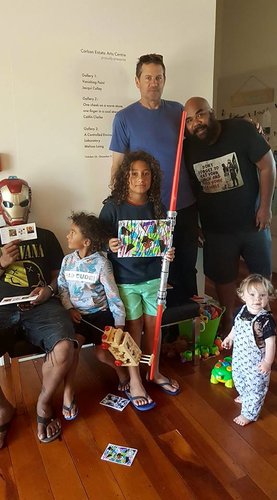
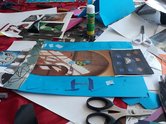

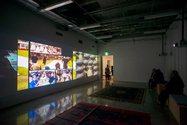
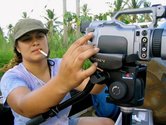
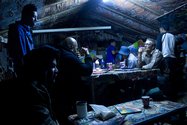
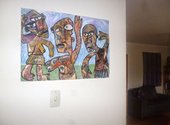
 Advertising in this column
Advertising in this column Two Rooms presents a program of residencies and projects
Two Rooms presents a program of residencies and projects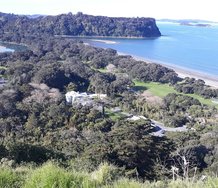
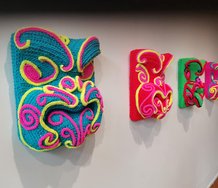

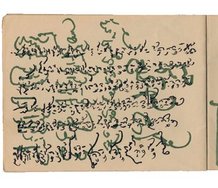
This Discussion has 0 comments.
Comment
Participate
Register to Participate.
Sign in
Sign in to an existing account.